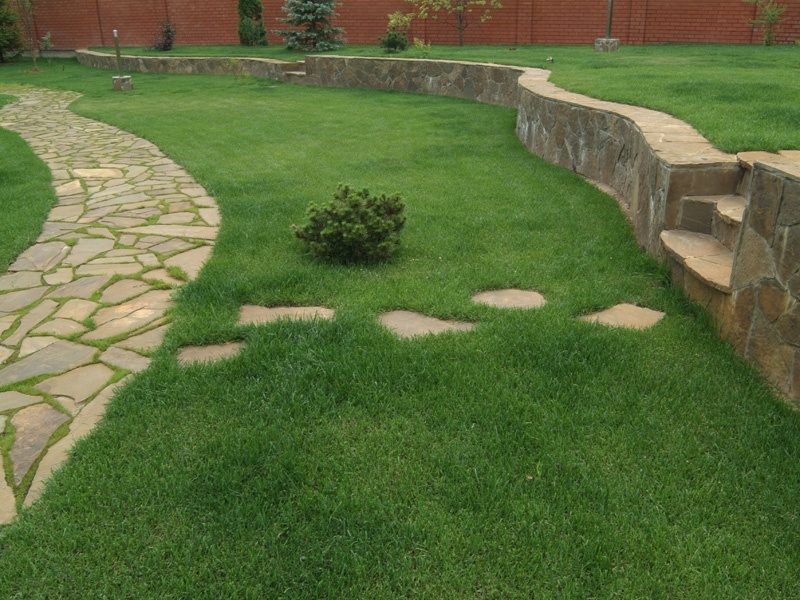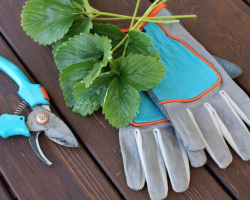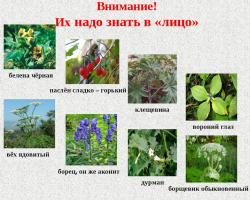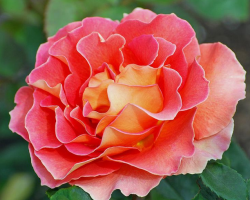Methods of destroying parliament of creeping: agrochemical, chemical and folk methods.
Content
- Porey creeping: what does it look at the beginning of spring, how propagates, on what soils it grows?
- Wheatfold: how to get rid of chemistry, herbicides, poison from wheatfly
- The fight against wheatgrass in the garden: Roundup
- Pyrey remedy: hurricane
- Siderates against Pyre
- Potato
- Video: manual rid of wheatgrass in small areas
- How to get rid of wheatgrass in strawberries?
- Video: how to choose herbicides correctly
- How to get rid of Purey in raspberries: herbicide
- How to deal with wheatgrass on the lawn?
- The struggle against folk remedies
- Video: Destruction of weeds using a soldering lamp
- Struggle against wheatgrass in the garden
- Pumpkin against wheatfet
- Correct tips: how to effectively fight weeds on the site?
- Video: Victory over wheatflow without chemicals - finally and irrevocably
Porey in a summer cottage? It is impossible to get out? We will tell you how to get rid of the "creeping" of the conqueror of the Earth forever.
Porey creeping: what does it look at the beginning of spring, how propagates, on what soils it grows?
Pirai is a long -term weed that quickly spreads on a land plot and delivers great chores to gardeners. Before telling how to deal with a malicious weed, we will imagine it in all its glory. As they say, the enemy needs to know by person.

- Porey creeping (Elytrigia repens) - a cereal herbaceous plant with a creeping branched rhizome that lies to a depth of 15 cm or more, quickly spreading to large areas. The root system of the plant can cover the territory up to 3 meters
- It has folk names: rzets, dog tooth, pony. The weed grows rapidly and can reach a height up to 1.5 m. Long linear leaves of green with a bluish tint. Has a flower in the form of an erect spike
- A weed plant can grow on different types of soils, even severely acidified. The ability of seed and vegetative propagation (pieces of rhizome), unpretentiousness, great resistance to drought and frosts, quick “conquest” of land squares, all this gives a reason to attribute a creeping prey to the most malicious weeds
- Seeds of wheatgrass germinate already in March at a temperature of +2 +4 °. The pointed elongated strip leaves get out of the soil, at the same time a powerful rhizome is formed, which quickly spreads and throws new plants to the surface of the soil

Wheatfold: how to get rid of chemistry, herbicides, poison from wheatfold
Herbicides
The chemicals to combat the green pest have proved their effectiveness and speed of action. System chemical reagents penetrate throughout the plant when spraying and act destructively on weed.
Important: the choice of herbicide should be based on the goal of achieving the effect: continuous removal of all plants on this site or selective exposure.
If you need to remove all plants on the path or between paving slabs, continuous herbicides are used. On lawns, large areas of garden crops, selective drugs are used for certain types of weeds.

Online stores and specialized gardening centers offer a large selection of chemical reagents to combat wheatgrass:
- Roundup
- Hurricane Forte
- Agroquiller
- Glyphos
- Tornado
- Graund
- Fyuzil Forte
Important: chemical methods of impact on wheatfold are effective, but we should not forget that by removing the “annoying” weed from the garden using herbicides, a person inflicts irreparable damage to living soil and its inhabitants. Plants planted on such land will be under the influence of these reagents for a long time. According to scientists, herbicides in one area should not be used more than once every three years.
When working with chemical herbicides, personal protective equipment should be used: glasses, respirators, gloves, dense clothing that does not allow herbicide to enter the skin.

New technologies in the fight against wheatgrass
Along with strong chemical herbicides, science represents new drugs that do not affect the soil composition and its inhabitants. Biochemists have found strains of microorganisms capable of feeding organic residues.
These are the so-called EM drugs. By processing the soil with these substances, the structure of the soil is not violated, but rather, the balance of soil cover and microflora is restored without digging and other traditional techniques of agricultural technology
When applying EM drugs to the root system of weeds, their death occurs as a result of EM bonding. In addition, effective microorganisms are a wonderful microbiological fertilizer.
Such drugs for soil processing deserve attention:
- Baikal EM-1
- Shine
- Renaissance
- Tamir
- Em-patoka
- Emix
- Humazat EM universal
The fight against wheatgrass in the garden: Roundup

Roundup He received well -deserved attention in the fight against many difficult -year -old cereal weeds, in particular, with a creeping parcel. A new generation herbicide is characterized by many indicators that deserve the trust of gardeners.
High efficiency. Roundup completely releases the treated area from weeds
Safety. Subject to the instructions for the use of herbicide is practically not dangerous for people and the environment
Important: Roundup, due to its low toxicity, is included in the register of permitted drugs by the Ministry of Health and the Ministry of Ecology of the Russian Federation.
Glyphosate - the active component of the rainapa has a systemic effect. After spraying weeds, the solution penetrates into all parts of the weed, reaching the root system 6-7 days after processing.
Roundap is processed soil before sowing and after harvesting for the prevention of land before the next plantings. For removal of creeping dust, working solutions are prepared according to the attached instructions. The solution destroys both individual plants and thickened herbaceous thickets.
Features of the use of the rang
- The working solution is sprinkled in dry calm weather in the complete absence of dew and rain moisture on the leaves of weeds
- It is permissible to storage the prepared solution for a week with a tightly squeezing dishes where the solution is stored
- Before processing, the herbicide should not be littered and weed
- After the Roundap processing, agrotechnical measures should not be carried out in the form of weeding, intake and loosening the soil within 5-7 days
- If the herbicide solution somehow hit the cultivated plant, it should be thoroughly washed off with water
Pyrey remedy: hurricane

- Hurricane Forte - Systemic herbicide of continuous action. Has an active substance - glyphosate, is considered an analogue of herbicide Roundup With the same chemical reagent. Produced in a container of different packaging, which is convenient for processing different sizes
- For spraying 1 hundredths of the garden, 20-40 ml of the drug in 3-4 liters of water should be diluted. Used before the harvesting and after the end of agricultural work in the fall
- It completely removes such difficult weeds as parliamentary prey, since it penetrates not only into the leaf part of the plant, but into the stem and root system. Hurricane Forte is a small toxic drug and is allowed for use. Safe for bees, environment and people
Important: when preparing a working solution, you should strictly adhere to the rules for the preparation of the drug, following the recommendations set forth in the instructions.
Council from experts: For a more efficient death of the root system of creeping dustproof, add 100-150 g of urea to 10 liters of a herbicide working solution. Ammonia nitrogen improves the delivery of the drug to the roots of a weed plant.
Siderates against Pyre

Delivering of soil from wheatgrass with the help of plant plants is an organic method of cultivation of the Earth. Having settled the site by the sectrates does not affect the environment of the environment and soil. The technique contributes not only to the removal of weeds, but also to aeration of the land cover and improve the structure of the soil.
The most common plant plants:
- sipetskaya mustard
- lupine
- fatselia
- buckwheat
- rape
- clover
- rye
- peas
Siderates are sown on land squares after shallow plowing (Fokin plane cutter, motor block or cultivator) a month before planting or immediately after harvesting.
Siderates, growing, displace weeds from the site. In addition, mowed and sealed grass of siderates, in the soil, improve its quality, contribute to the natural aeration of the Earth and its fertility. The sown siderates do not allow the root system of wheatgrass to grow, and gradually the soil will be cleansed of malicious weed.
Potato

- It is not difficult to prepare a bed for potatoes in a summer cottage. Many gardeners prefer an ecological way to destroy wheatgrass in a small area: autumn digging of the Earth followed by choosing a rhizome. Moreover, the soil should be digged with a fork in order to avoid rupture of the roots of the wheatgrass, which provokes a new growth of the root system
- But how to deal with weed on large areas of potato field? This method will be very difficult. Herbicides can not do here. Roundup, Tornado, Hurricane Forte - Modern high -tech systemic herbicides, which are used by spraying on weed plants according to the attached instructions for use
- Effective late soil processing with reagents or after harvesting. During spring spraying, pre-sowing the site is recommended or 3-5 days before cultural seedlings
Video: manual rid of wheatgrass in small areas
How to get rid of wheatgrass in strawberries?

Fighting wheatfold in strawberry beds is problematic, but possible. We give some tips on how to do it.
- If the prey was filled with strawberry beds, planting should be discharged. It is recommended to remove old and weak plants. This helps to improve ventilation between strawberry bushes and makes it possible to dig nearby dust. Then you should manually remove the weed along with the root system
- With a large accumulation of wheatgrass, weed can be treated with systemic herbicide. In this case, the spraying method is not suitable. The working solution should be applied carefully on the weed with a brush, making sure that the herbicide does not get on the leaves of strawberries. Herbicides processing is best done in the fall after harvesting
- Fyuzil Forte - System herbicide, allowed to remove perennial cereals in strawberry beds. After processing with herbicide, the soil should not be loosened for two weeks. During this time, the rhizome of Pyre is completely dies
Important: Use strawberries herbicides in extreme cases, if possible use other weed combat methods.
- Strawberry aisles should be filled with sawdust or straw, such a coating will not allow weeds to break through
- To destroy wheatflower in strawberries, and other weeds, the method of growing berry culture by mulching film will help. This method has been widely used in gardeners recently
Video: how to choose herbicides correctly
How to get rid of Purey in raspberries: herbicide

- Creeping dust is a dangerous weed plant for raspberries. Since the berry shrub is responsive to organic matter, rows and interrasia of raspberries quickly overgrown with vacuum. The root system of weed is firmly intertwined with raspberry roots, and nameplate (underground shoots) can even pass through them. Therefore, it is difficult to derive dust on the raspberry growth site
- Verira can be removed by selective processing herbicides of continuous action: Roundap, Tornado, Agroquiller, Hurricane Forte. The working solution is prepared strictly according to the instructions. Weed plants are treated with a brush over the surface of the aboveground weed. At the same time, it should be paid to the working solution does not fall into young raspberry shoots
Important: an alternative to the chemical struggle against wheatgrass is the method of mulching the rows of berry shrubs with sawdust, straw. Mulch does not allow weed plants and supports the soil in a wet state.
How to deal with wheatgrass on the lawn?

- Spring is considered the best time to remove wheatgrass, like all weeds. When single specimens appear on the lawn, you should immediately remove them along with the root, tidying the plant without damage to the roots
- If this is not done right away, fast -growing and ubiquitous roots of Pyrey will quickly occupy a significant part of the lawn. In addition, there is a chance to grow up and disperse the seeds into the well -groomed territory of the lawn. Then with wheatglance you will have to fight in other ways and it will take much more time
- When planting lawn grass, the soil from weeds should be completely secured. It is best to use herbicides before sowing herbs. But, if wheatfields, sowing, dandelions, which are difficult to fight manually, should be grown on a well -groomed lawn, selecting herbicides should be selected. For these purposes, the drug has proven itself well Agroquiller
The struggle against folk remedies

Verira is so annoyed by summer residents and gardeners that everything is used - both the latest chemicals and the time -tested folk methods and means. We will share the most common and affordable recipes for getting rid of malicious weed.
Soda
Sodium bicarbonate or food soda can easily be bought at any supermarket or pharmacy. A rather aggressive reagent will help destroy single specimens of wheatgrass and other weed grass between the tiles of the garden path or recreation sites. To do this, prepare a strong soda solution and spill it onto the broken grass.
Salt
Sodium chloride or food salt is also a cheap means of getting rid of weeds. Salt crystals should be scattered along weed plants around planted crops. After watering, the salt is absorbed into the soil and brakes the sprout of weeds.
Blowtorch
Furning, in the literal sense of the word, the young crushed wheat lamp is an effective method of getting rid of a green enemy. It is a pity that this method does not allow to remove the root system of perennial dust.
Video: Destruction of weeds using a soldering lamp
Fire grain
- The method has found widespread use in foreign countries. A sufficient test and positive result gives rise to use this methodology to combat weeds
- Fire grain is grain waste in the processing of corn, oats, wheat and other grain crops. It is mainly used for the manufacture of livestock feed and poultry
- The mechanism of exposure to fodder grain on weeds is the presence of a certain gluten, which acts as a contraceptive for the germination of weeds
- The method is used in the middle of the season, when cultivated plants have become strengthened and gained a sufficient root system. Fire grain wakes up around cultivated plants with a small layer and blocks the appearance of new weeds from seeds
Ethanol

The method of processing the soil with diluted ethanol before planting plants came to us from America. I'm afraid that our summer residents are unlikely to follow the foreign advice. How can such a valuable product be poured into the ground? But the method has the right to exist. In the same way, as American farmers declare, the site processed in this way will not overflow weeds, at least in the current season.
Ethyl alcohol is diluted with water in a ratio of 1:10. The resulting solution is processed about 30 days before planting. 11 liters of this mixture are enough for processing 2-2.5 acres of the site.
Lemon acid
In 1 liter of hot water, 3 tablespoons of citric acid are dissolved. Weeds are sprayed with a solution in sunny calm weather.
Mulching
The principle of mulching lies in the complete concealment of access, sun and air to sprouted weed plants and the inability to break their seeds. Mulching material gives reliable protection against weed grass to garden plants and floral crops.
As mulching material can be used:
- polyethylene film or fiber fiber
- sawdust
- expanded clay or gravel
- grinded crust of trees
- small grass
- improvised material
To remove a large accumulation of wheatgrass in the beds, you need to be patient to wait for the result for 3-4 months.
- First, the beds are marked for growing garden crops
- The surface of the marked earth is tightly covered with film, cardboard, old linoleum or dense matter
- On top you can pour a volumetric layer of beveled grass or straw
- After 3-4 months, the shelter can be removed and soil processing
- You can delete dust in this way in early spring, when the plant just begins to show from the ground. For the winter you can also mulch the areas with a cut
Struggle against wheatgrass in the garden

Experienced summer residents have long known the method of combating vacuum and other perennial weeds using vinegar solution.
For the preparation of herbicidal soap The "killer of weeds" take:
- strong vinegar (15-20%)-3.8 liters
- salt - 0, 5 cup
- any detergent - 1 teaspoon (for better adhesion of the solution)
- All components should be mixed properly
- Held dust in the morning in dry weather
- Abundantly spray the entire surface of weed grass
Processing by ordinary 9% table vinegar from a spray gun also contributes to the death of leaf greens of weeds.
This method of processing is effective for eradicating annual weeds. In the case of rib and other perennial herbs, the method is suitable only for removing the green mass of the plant. The root system of Pyrey remains in the ground and after a while the young wooden shoots will gain new land areas.
Important: a vinegar is a rather strong reagent, so you should carefully spray it without getting into cultivated plants.
Pumpkin against wheatfet

- The American Indians were the first to use the pumpkin in the fight against weeds. They used pumpkin, corn and beans in joint stands. Large pumpkin leaves covered the soil from weeds, and corn gave a support for beans. The environmental and simple method should be adopted.
- On a area, with a choppot and other weeds, pieces of turf are cut out with dimensions of 30x30 cm at a distance of 1 m from each other. The turf is turned upside down. Pump up on cut pieces
- Weeds are mowed on the aisles. This is done once, then large teen leaves will close the surface of the site and will not allow weeds to grow. This method will free from weeds and boundaries of the site. For this, the seeds are planted pumpkin along the fence of the site, and the lashes are allowed towards the boundary

So what to choose?
At the end we will summarize. Gardeners fight wheatgrass in the following directions:
- speasing and weeding Pyrey
- drawing of the soil followed by choosing a rhizome
- removing wheatgrass using covering materials and mulch
- chemical exposure to weeds with herbicides and other reagents
You can’t definitely say which method is better, everyone has its own pros and cons.
- Slim and weed the grass will have to be several times in the summer. This method for a short time removes wheatgrass. After all, the creeping root of the plant continues to remain in the soil and grows further further
- Choosing a rhizome from the digested earth is a rather long and time -consuming way of getting rid of dust. It's a shame that such tiring work will not guarantee the complete destruction of the weed. The broken roots can not be selected from the ground. Over time, they will give the life of a new shoot
- Herbicides perfectly cope with their task to destroy the malicious plant. But, it cannot be guaranteed that the chemical reagent will not fall into other garden plants, and with them and to our table
- Shelter of beds overgrown with wheatgrass, covering material and mulch is an effective and safe method of getting rid of weed grass
- Sowing of Siderates is an ecological way to get rid of weeds in organic farming

And at the end of the article - a bonus:
Correct tips: how to effectively fight weeds on the site?
- Mettleer's organic agriculture and beds are an ideal solution to weed grass
- Pointed by top dressing and fertilizers will not give the possible prosperity of weeds. Fertilizers should be made only before planting and in the places of the future growth of plants. Arbitrary fertilizing only stimulates weed growth. In the future, seasonal planned top dressing should be done
- The early nesting struggle of weeds: weeding and physical removal of weeds with the root system will help not to launch ”the site. Do not forget about the Sapa and the rake in the future. Carry out sanitary weeding throughout the season
- Mulching is your reliable ally in the fight against weeds. Use mulch on the beds, in flower beds, on the paths between the beds, in the trunk circles of fruit trees
- The use of black film on the beds with strawberries, zucchini, tomatoes and other crops will help to avoid the dominance of weeds
- The use of drip irrigation is a revolutionary breakthrough in plant cultivation. The benefit of such watering lies not only in the economical consumption of water, but also in the targeted delivery of life -giving moisture to the right plants, leaving weeds for weeds without water
- Do not leave the soil bare. Should immediately cover it with a black film, planted with gidrats or cultivated plants
- An annual rotation of cultural planting contributes to the eradication of weed grass
- A predominant way of growing plants is seedlings, and not through seeds
Important: should not be forgotten: to achieve effective results in the fight against the most malicious weeds is possible only with a systematic struggle, and not in their episodic destruction.








Free borders from weeds (wheatfly) - an effective way!
Thank you for an interesting article